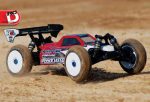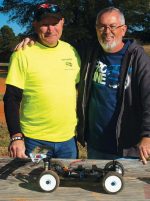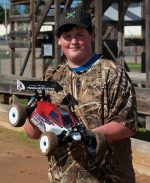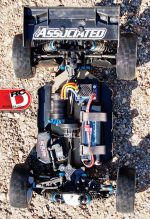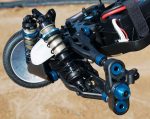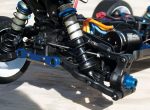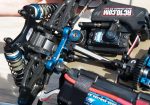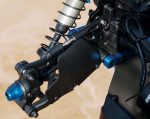AE’s RC8B3 gets electrified!
This article was originally published in RC Driver’s February 2016 issue.
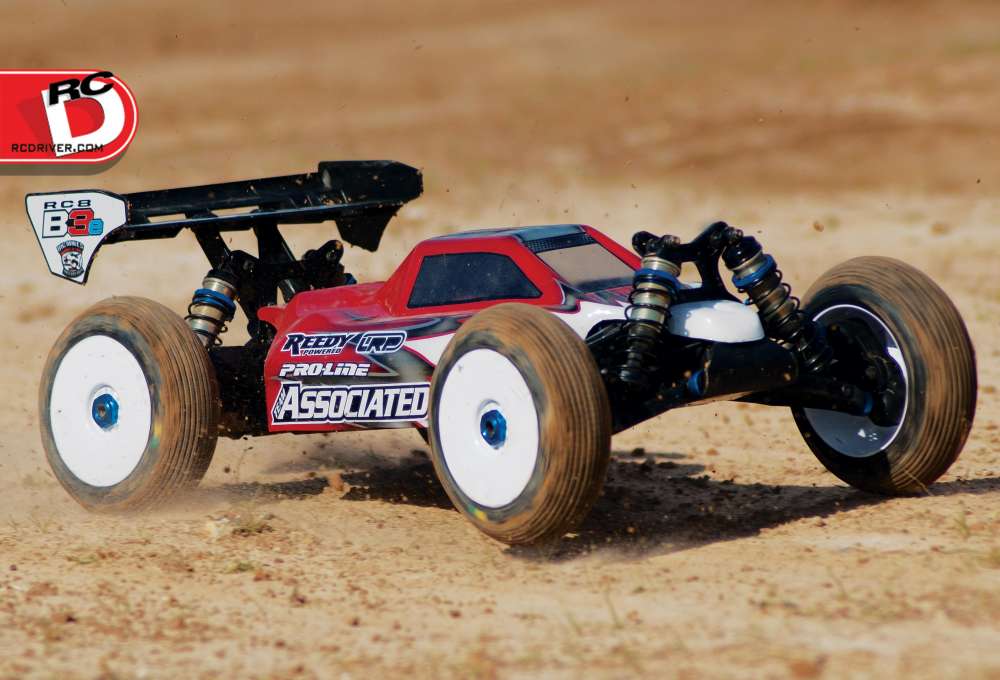
Photos: Tony Phalen
As we certainly expected, Team Associated announced an E-version of their highly anticipated RC8B3 Nitro buggy shortly after its release. Using over 90% of the parts from its Nitro cousin, the RC8B3e has all the same track manners, but with the explosive nature of electric components. While E-buggies have never quite reached the same degree of greatness, their tenacity on the track is just as potent. As a reward for being a great guy (right Greg?), I was able to secure the review for this breathtaking buggy and be the first on the block (or at least in our office) to give it a whirl. Oh what a whirl it was!
AT A GLANCE
WHO MAKES IT: Team Associated
WHO IT’S FOR: Intermediate to advanced racers
PART NUMBER: 80916
HOW MUCH: $539.99
BUILD TYPE: Kit
PROS
• A spittin’ image of the already popular
• RC8B3 Nitro Buggy Shares over 90% of the above buggy’s parts
• New pillow ball front suspension
• Easy access front, middle and rear diffs
• The ever plush, 16mm Big Bore shocks
• Full set of universal driveshafts
• Sliding motor mount adjustment
• Robust turnbuckles (4mm front/5mm rear)
• Big electronics box
• Genuine Proline RC8B3e body
• Two wing-mounts to choose from
• Excellent handling
CONS
• A few minor build issues (see Feature Breakdown)
REVIEWER’S OPINION
Unfortunately, I did have a few minor hiccups during the build process, but nothing that I couldn’t figure out. Study the steps prior to assembly and you should cruise right through the build. The manual is excellent and easy to understand. Having run a tank or two through the RC8B3 Nitro buggy back when Greg reviewed it, I was pretty confident that this buggy would feel the same way. That’s great because when it came time to test, I had a small crowd ready to check it out. The out-of-the-box setup is a great starting point and with all the tuning adjustments, I’m sure you’ll be able to target that perfect setup in no time.
ITEMS NEEDED
• Servo
• Electronic Speed Control
• Brushless
• Motor
• Transmitter
• Battery
• Pinion
• Wheels
• Tires
• Paint
ITEMS USED
• Reedy RS1508 Digital HV Servo I’ve used this servo quite a few times in 1/10 applications and always thought it was a bit overkill. Dropping it into a 1/8-scale was like adding chocolate to my peanut butter – the perfect combination. The healthy 212oz/in. of torque was plenty powerful and kept the buggy’s front tires pointed in the direction I wanted, even when I was overdriving the car through the corners.
• LRP iX8 V2 Brushless ESC Since Reedy doesn’t have a 1/8 scale ESC that they can add to the build package, I opted to use a LRP unit instead. Thankfully, this was perfect timing as I not only got to use the iX8, I had a chance to try out their new iX8 with the V2 software. This ESC has extremely smooth power delivery, so much so that I felt like I was running a 2- or 3S LiPo pack … that is, until I romped on the throttle.
• Reedy Wolfpack 4000mAh 35C 4S LiPo Battery I was a bit surprised when I opened the Wolfpack box – this 4S pack is pretty small compared to other 4S LiPo packs. But size didn’t seem to matter; this battery gets the RC8B3e howling around the track! Even though it’s only 35C and 4000mAh, it felt great around the track and provided run times of around 13-14 minutes, even while running full-clip around the large, outdoor track.
ADDITIONAL ITEMS USED
• Futaba 4PX Radio System
• Reedy Sonic 1512 Competition 2100Kv Brushless Motor
• Robinson Racing Mod1 13t High Carbon Steel Pinion Gear
• Pro-Line Fugitive X3 Pre-Mounted Tires
• Paint by Kustom RC Graphics
HOP-UPS WE RECOMMEND
• 81029 Factory Team Carbon Fiber Rear Shock Tower While the weight difference is marginal, the carbon fiber rear shock tower will give you a defi nite Factory look. That in itself is worth a few tenths per lap!
• 81213 – 81220 Shock Spring Set Having some tuning parts in your pit bag will help you dial in your buggy to almost any track condition. Don’t just settle in with the stock springs pick up the whole set!
• Silicone Diff Fluids Another item to have in your pit bag is a good assortment of diff fluids. I would suggest finding out what works best at the track you’re at and pick up a few bottles in that range. That will allow you to adjust up or down to suit your driving style
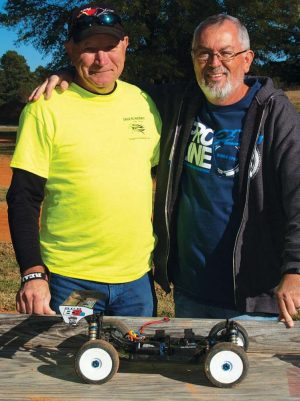 FEATURE BREAKDOWN
FEATURE BREAKDOWN
The backbone of the RC8B3e is a 3mm thick piece of machined 7075-T6 aluminum. It has pockets milled out for weight saving and to help sink items like the servo down in the chassis for the lowest possible CG. It is hard anodized for extreme durability and has molded side rails attached to each side to help keep dirt out. Each side rail also has small pockets molded into them so you can use Velcro to help secure the body. Supporting the front and back of the chassis are a pair of molded braces. These create a rigid platform and reduce the front-to-back flex in the car. The right side of the chassis has a servo tray that includes a sealed receiver box. This box can house my receivers (depending on size) as well as a transponder. Just behind the servo tray sits the motor mount system. A battery tray and ESC mount the full-length of the left side.
The RC8B3e comes with a fantastic suspension, including 16mm hard- anodized Big Bore shocks, thick turnbuckles (4mm up front/5mm out back) and a complete set of aluminum arm mounts. For added durability, both the front and rear shock towers are machined aluminum with the front being a whopping 5mm thick and the rear 4mm. The suspension arms are equally chunky for maximum strength. Those are all great talking points, but the area that might catch your eye first is the newly designed pillow-ball front suspension. This is the first time AE has included this type of front end in their 1/8-scale lineup (other than the RC8B3), typically using a C-hub design. It is a little more involved to build, but the benefits on the track are well worth it. To boost reliability, AE has included items like aluminum suspension arm end caps (where the pillow balls feed into the upper arm to reduce the risk of the balls yanking out during a crash) as well as steel pillow balls. Also used are aluminum nuts that screw into the steering block to capture the pillow balls. These were a bit of a pain to install, so take your time and feed them in slowly to reduce the chance of cross threading them.
The RC8B3e uses a standard dual-bellcrank steering system that rolls on a set of precision bearings. It features an integrated servo saver and is built with a very muscular appeal, having thick molded parts, an aluminum steering rack and servo saver tube. Even the aluminum posts key into the chassis to prevent them from spinning or loosening up. The 4mm turnbuckles thread easily into the thick ball cups (yes, I did say easily) and are angled and attached to the steering blocks for maximum wheel clearance. There is quite a bit of throw in this system and you’ll notice it on the track. I haven’t had a whole lot of time to mess with this front end yet, but it feels much smoother than any of my C-hub cars ever did.
To handle all the immense power and different driving styles, the drivetrain on any 1/8-scale has to be bulletproof. Starting at the beginning, AE has equipped the RC8B3e with an aluminum motor mount system that uses a slider to adjust the gear mesh. The center diff uses a Mod1 spur gear that spins the long, 3mm universals to both ends of the car. Front and rear fluid-filled gear diffs reside in easy-access housings; to extract, simply remove a rear hatch (or front hatch for the front diff) and slide out.
Universals reach out to all four corners of the car where 17mm hex drives allow attachment of the wheels and tires. The system feels extremely smooth and is very durable. This is one of the first things I look at after a few runs to see if any of the universals are bent.
There are a few other cool features I’d like to point out. To attach the shocks, AE uses a ‘keyed’ upper mount point on the tower to prevent the standoff from loosening up. On the bottom, a pin slides through the arm and is captured by a setscrew. This eliminates the need to use normal screws on one side and reverse thread screws on the other. The ESC mounts right behind the battery and uses a better, down- low routing system. I say better because now the ESC wire is out of the way, unlike previous models where you had to route the wire up and over the universal. Additional items like rear mud guards, easy-access anti-roll bar mounts and optional wing mounts are all welcome features.
I do want to point out the few minor build issues I had. First off, if it appears you are missing a screw or locknut during a certain step, don’t be alarmed it’s probably in a different bag. I had this happen and just kept on building, only to find the M3 locknut in a later bag. I want to mention these again; the aluminum pillow ball nuts will drive you crazy so take your time and be careful not to cross-thread. The motor mount system is great, but it felt a little notchy when trying to set the gear mesh. Pull it apart and make sure there isn’t any flashing on the aluminum. Also, when attaching the pinion, pay close attention to how far in the setscrew goes. If it sticks out, you may encounter interference issues if you set it flush with the spur gear. I had this issue and had to pull it away from the motor a tad so it would rotate without hitting the mount.
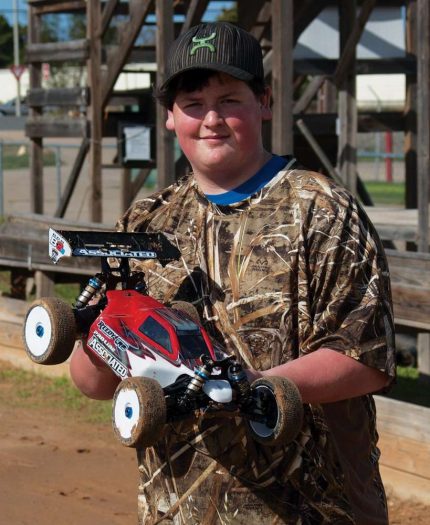
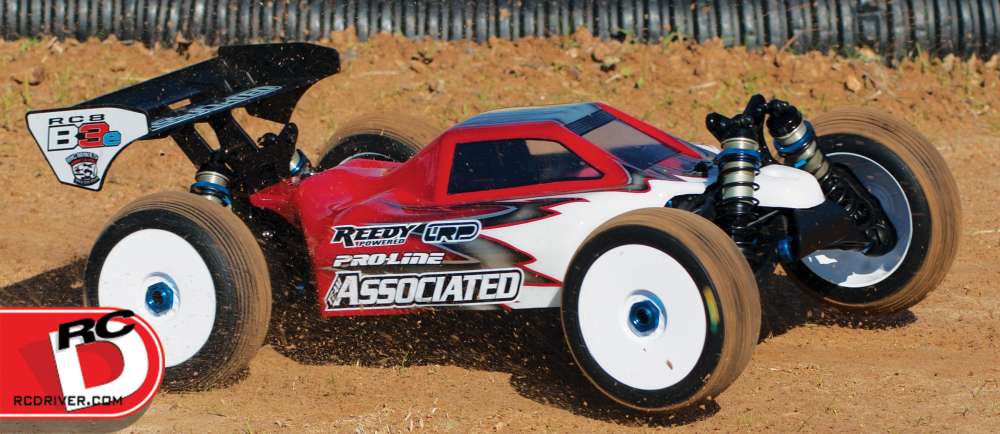
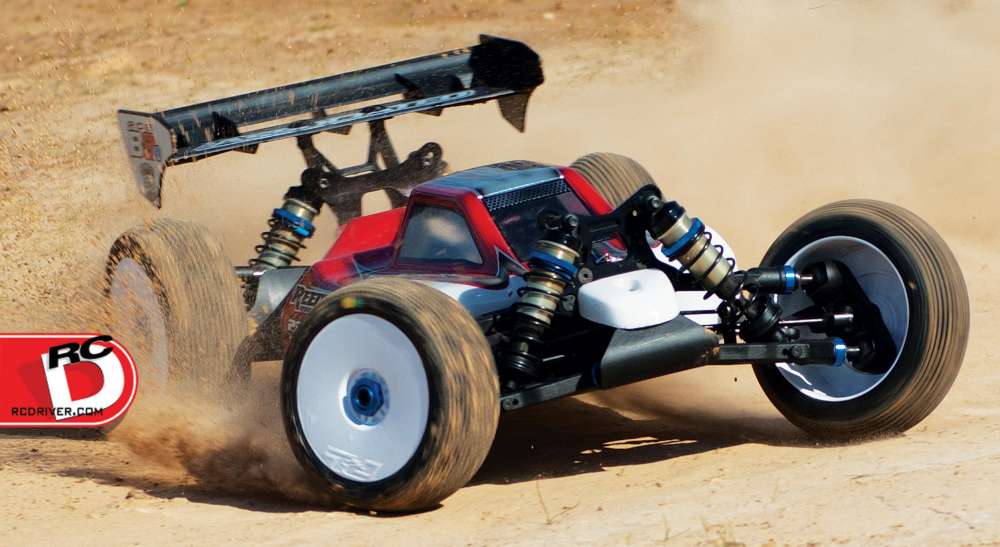
ON THE TRACK
Since the wife and I had to make our way to Texas for Thanksgiving, I wasn’t able to run this car at any of my local tracks. However, I was fortunate enough to get a chance to run it at TWO different tracks in the East Texas area; Eagle RC Raceway in Tatum and T&T Speedway in Shreveport, Louisiana (both tracks feature a clay surface with areas of light sand). Eagle Raceway is a wide open track that is perfect for testing the high-speed handling with sweeping turns and big jumps. Don and Frank, the owners of the track, opened it up for me for the day so I could air the buggy out. T&T Raceway was a bit smaller and tighter, so it was perfect for testing on a more technical layout. It was great being able to have double the test time and on two different tracks.
STEERING
At both tracks, the RC8B3e had excellent steering, but I felt at T&T it had just a touch of oversteer exiting corners. I had to adjust my driving style a little bit for the first pack and eventually got it under control, but I didn’t like the feeling of having to change so much to compensate for the car. I made a few quick changes to the buggy (rear camber link location and ride height) and it responded very well, however, I still think it needs a little more tuning to completely lock it in. The Reedy RS1508 servo, on the other hand, is quite amazing. At times I had to do some sawing at the wheel to keep the buggy going straight and this servo kept up with every move.
ACCELERATION/BRAKING
As you would expect, the RC8B3e’s 4WD system coupled with super-grippy Pro-Line tires launched this buggy like a bullet from a gun. At both tracks, the tires dug in to the clay surface, creating only a slight roost as it rocketed from corner to corner. Even on the short run-up sections before any jump (there were a few), I had zero problems clearing the gaps. I did experience a little wheelspin where areas of top sand were present, but it was controllable. The same can be said in any of the braking zones. The LRP unit has an enormous amount of braking power, so much so that I had to dial it back a bit or risk throwing the battery pack through the windshield!
HANDLING/JUMPING
Through the slower corners, the steering is excellent and the rear feels completely locked in. Rotation is good too, however, I think with some additional tuning (or different tires for this particular surface) it could be a bit better. As I mentioned in the Steering category, the rear of the buggy would skip out some in the faster corners if you weren’t on top of it. A few changes helped control that but, again, some additional tuning (and tires) will certainly transform this buggy. Thankfully AE has loaded this 1/8-scale with an enormous amount of tunability, so it’s just a matter of finding the right combination. Jumping, well, this is where the RC8B3e excels. Big jumps, small jumps, it doesn’t matter. Air time is your friend when wheeling this buggy around. Landings are plush and controllable thanks to the superb suspension and, especially, the awesome Factory Team shocks.
DURABILITY
While I did all of the driving for the review, I had new friend, 14-year-old Cody Chambers, wheel the buggy around at T&T for photos. He’s new to 1/8-scale (he’s got one of those other cars), but was super-excited to pilot it, even if it was for controlled pictures. He pitched it around corners, through some of the rougher sections of the track and even over the big jumps. While not every attempt landed exactly as planned, I was able to ease his mind knowing that this buggy would come out in perfect condition. 1/8-scale buggies are built pretty solid these days and, as I expected, the RC8B3e passed this test with flying colors. Maybe a little dirtier, but no broken parts.
for in-depth reviews on the latest RC vehicles
SPECS AND TUNING OPTIONS
DIMENSIONS
LENGTH: 19.2 in. (488mm)
WIDTH: Varies
WHEELBASE: 12.9 in. (327.3mm)
WEIGHT: Varies
BODY, WHEELS AND TIRES
BODY: Clear Lexan Pro-Line RC8B3e body
WHEELS: Not included
WHEEL ADAPTER TYPE: 17mm hex
TIRES: Not included
SUSPENSION
TYPE: 4-wheel independent
SHOCK POSITIONS: (F) 5-tower, 2-arm, (R) 5-tower, 2-arm
CAMBER: Adjustable turnbuckles
ROLL: Adjustable inner link heights
WHEELBASE: Adjustable with shims
RIDE HEIGHT: Threaded shocks
STEERING
TYPE: Dual bellcrank
TOE: Turnbuckles
CHASSIS
TYPE: Flat with molded sides
MATERIAL: Hard-anodized 7075-T6 aluminum
THICKNESS: 3m
DRIVETRAIN
TYPE: 4WD TRANSMISSION: N/A
DIFFERENTIALS: Three fluid-filled gear diffs
BEARINGS: Full shielded
CLUTCH TYPE: N/A GEAR RATIO: Optional pinion gears
RATING TALLY
Opinion: 9
Performance – Acceleration: 9
Performance – Steering: 9
Performance – Handling: 9
Performance – Durability: 10
Feature Breakdown: 10
Overall Value: 9
WRAP UP
Team Associated has taken a big step toward E-buggy supremacy with the design of the RC8B3e. There are vast differences from previous models, but I think sometimes you have to make big changes to reap big rewards. I’ve driven every 1/8-scale E-buggy AE has produced and can honestly say that, out of the box, this one has been the best yet. I’m really excited to dive right in and start racing it! I’d like to thank the crews at both Eagle RC Raceway and T&T Speedway for their hospitality and also Cody Chambers for being a great test driver. Keep at it, kid!
LINKS
Team Associated, rc10.com, (949) 544-7500
Reedy, reedypower.com, (949) 544-7500
LRP, lrpamerica.com, (949) 276-6060
Futaba, futabarc.com, (217) 398-8970
Pro-Line, prolineracing.com, (800) 899-7223
Robinson Racing, robinsonracing.com, (559) 692-2465
Kustom RC Graphics, kustomrcgraphics.com, kustomrcgraphics@aol.com
Eagle RC Raceway, eaglercraceway.com
T&T Speedway, tandtspeedway.com, (318) 671-8896
 RC Driver The Best In RC Car & Truck News, Reviews & Video
RC Driver The Best In RC Car & Truck News, Reviews & Video 


